PRESS RELEASE: POST PANDEMIC PET CARE TIPS FROM DR. KATRINA WARREN & PETSAFE – INTERVIEWS AVAILABLE

DR. KATRINA WARREN & PETSAFE® BRAND AUSTRALIA GIVES 6 TIPS TO AVOID ANXIETY
APRIL 2020: As many Australians prepare to return to the office after many months of working from home, PetSafe®Australia is urging pet owners to follow some simple tips to help prepare their four-legged family members as well.
During the past year, pets have become dependant on their owners being home 24/7. But as some of us start to return to life post-pandemic, our pets are at risk of suffering from separation anxiety – a potentially debilitating and destructive psychological condition that is thought to affect one in every four to six dogs.
PetSafe®Australia has partnered with Australian vet and TV presenter Dr. Katrina Warren to develop six simple tips that can help make the transition back to our daily schedules easier for you and your furry loved ones.
“Any animal that bonds closely to a human can experience anxiety when they are suddenly separated,” shares Dr. Katrina. “However, dogs bond very closely to humans and seem to suffer the most.”
Cases of separation anxiety in dogs are expected to rise as we begin to return to the office. But how can you tell if your dog is doing it tough? “There are a few signs that quickly hint to us that a dog is anxious,” says Dr. Katrina.
“When COVID-19 is a thing of the past and we all return to our normal routines, you might see changes in your pet’s behaviour,” says Dr. Katrina. “In adolescent dogs, this might be pure boredom – but others they may be experiencing separation anxiety.”
“Dogs with separation anxiety become extremely stressed when separated from their guardian. This can manifest in a variety of behavioural issues, for example, barking and howling, a change in toilet habits, and destructive behaviours like chewing and digging.”
All of these things can be costly for you ¬– not to mention exhausting for your neighbours – and the added stress for pets and their human parents alike is not needed.
“More serious signs of separation anxiety can include loss of appetite, hiding in corners, panting or whining or trembling,” advises Dr. Katrina, “and might require your vet’s support to manage.”
Dr. Katrina and PetSafe® Australia recommend the following six tips that may help your dog avoid developing separation anxiety and reduce everyday stress levels when you return to work.
1. Do some exercise!
Make sure your dog has a decent walk or gets some energetic exercise before you leave for the day. A tired dog has less energy to be anxious and destructive.
2. Leave a challenging treat
Just as you’re leaving, give your dog a chewy treat that will take his or her mind off your departure. Treat-dispensing toys like the PetSafe® Busy Buddy® range are the perfect solution as they can occupy dogs for hours as they work to get the treats.
3. Keep calm on your departure and return
Don’t make a big fuss when you are leaving the house or coming home. Stay calm and emotionless. If your dog gets excited and jumps all over you when you arrive home, ignore them and walk away calmly. Greet them only when they have calmed down.
4. Set up a realistic routine and practice it
In the days and weeks before you head back to work, get your dog used to a routine that will be manageable once you are actually working away from home again. For example, if you are going to go for shorter walks and at different times to what you do currently, start getting them used to the changes as soon as you can.
5. Create a dedicated ‘doggy den’
This is a safe space where your dog can always go and know they won’t be disturbed. It could be a kennel, a pen, a crate, or their bed area – whatever you use, it’s a spot they can always retreat to in order to relax and feel safe. Get puppies used to these areas from the time you bring them home by encouraging them to have their chew toys there and sleep there.
6. Find a pet sitter
Leaving your dog with a friend, relative or a dog-sitter is a great option; or if your dog gets on well with other pups, try doggy day-care. This doesn’t need to be a long-term solution – start with five days a week, then ease them down gradually, a day at a time, so they can slowly get used to days at home alone.
If you are concerned about your pet’s anxiety, seek professional advice from your vet. You may need help from an animal behaviourist, and some serious cases may be prescribed an anti-anxiety medication, which they can reduce or wean off of in time.
Whatever steps you take to help ease your furry friend’s transition back to solo time when you go back to work, don’t delay! There’s no time like the present. A gradual transition is far better than a sudden empty and very lonely family home. Start increasing your stints away from home and getting your pet used to their own company again as soon as possible.
-END-


 PetSafe® Brand is a global pet product expert with its headquarters in Knoxville, Tennessee. Wide-ranging innovative products are available across the PetSafe® Brand product portfolio including training, containment and lifestyle and wellbeing product solutions. Visit www.petsafe.net/AU for further details or connect on Facebook or Instagram.
PetSafe® Brand is a global pet product expert with its headquarters in Knoxville, Tennessee. Wide-ranging innovative products are available across the PetSafe® Brand product portfolio including training, containment and lifestyle and wellbeing product solutions. Visit www.petsafe.net/AU for further details or connect on Facebook or Instagram.
